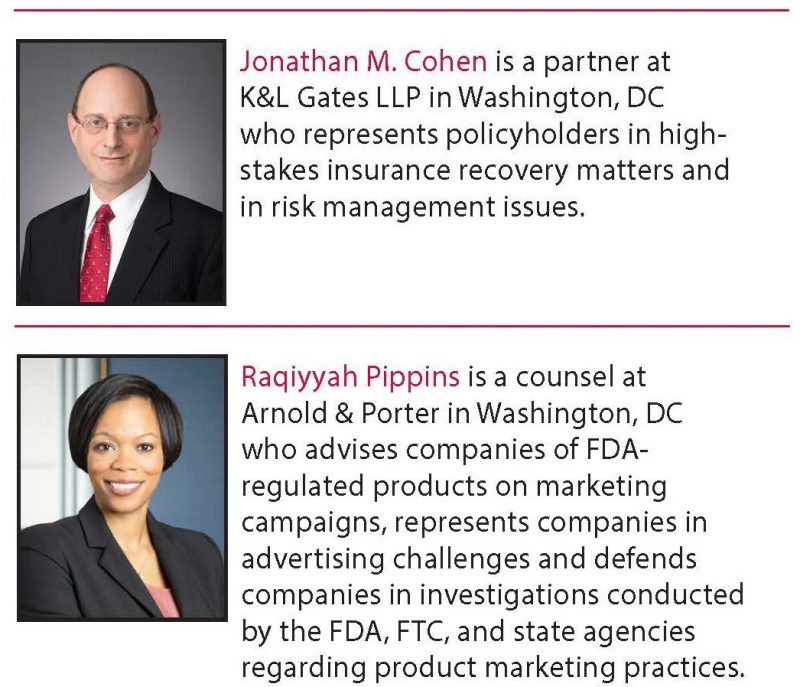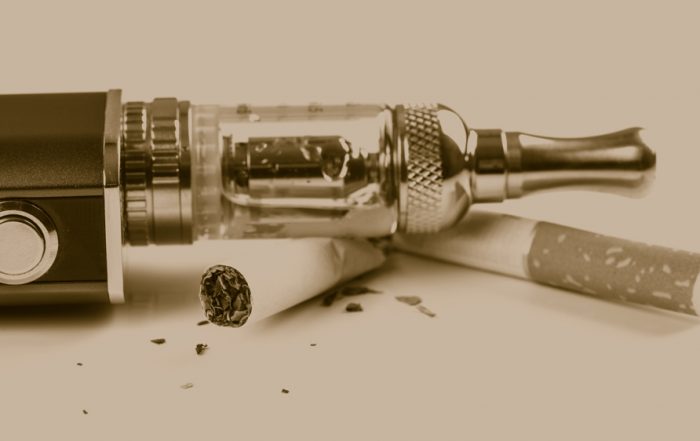
You’re in Better Hands Than You Think: Insurance Law May Provide Coverage for Defense of Advertising Claims
by Jonathan M. Cohen and Raqiyyah Pippins
It is no secret that advertising litigation involving FDA-regulated products has been on the uptick in recent years. What is less known is that there have been significant developments in case law that may help advertisers obtain coverage for their advertising-related litigation expenses.1
Generally, discussion regarding false advertising litigation is focused on consumer class actions questioning the veracity of product content and performance claims. The increase in false advertising litigation, however, has not been limited to actions filed by consumers. In the past year, over a dozen Lanham Act complaints regarding FDA-regulated product advertising were filed, with six involving claims that the defendant’s advertising claims were falsely denigrating the plaintiff’s product.2
Companies May Have Insurance That Covers Comparative Marketing and Advertising Claims
Although these litigation trends have led many companies to consider the financial risks associated with comparative product marketing claims to be substantial, many companies have insurance policies that might cover some or all of their defense or liability costs for such claims. Under some policies, companies may have coverage for claims alleging product disparagement, as well as claims alleging misrepresentation or false advertising.
Most companies in the United States have insurance under a standard-form general liability policy. Typically, general liability policies cover damages that a company becomes obligated to pay to third parties because of, among other things, specified “advertising” or “personal” injuries.
General liability policies usually define advertising or personal injury to include a laundry list of “offenses” that trigger coverage. Some categories of offenses are limited to harms allegedly committed in the course of a company’s advertising activities. These categories typically include “the use of another’s advertising” in the policyholder’s advertisement and the infringement “of another’s copyright, trade dress or slogan” in the policyholder’s advertisement. These standard-form coverages mean that general liability policies may provide at least some coverage for claims of advertising misappropriation or for certain categories of copyright infringement in the course of an advertising campaign.
Significantly, general liability policies also cover damages arising from the “oral or written publication of material that slanders or libels a person or organization or disparages a person’s or organization’s goods, products or services.”3 Whether an advertising or marketing claim results from slander, libel, or disparagement is an oft-litigated issue.
Lessons Learned
As an initial matter, many courts have held that terms in an insurance policy have their ordinary, dictionary meanings, rather than a technical legal meaning. See, e.g., Foster Poultry Farms, Inc. v. Certain Underwriters at Lloyd’s, London, Civ. No. 1:14-953, 2016 WL 235211, at *8 n 8 (E.D. Cal. Jan. 20, 2016) (“a multifaceted term that is undefined in an insurance contract ‘is not given a narrow, technical definition by the law’” (quoting Michaels v. City of Buffalo, 651 N.E.2d 1272, 1273 (N.Y. 1995))). Under this principle, an insured may assert that the general liability policy should cover a third-party claim grounded on disparaging, slanderous, or libelous statements, even if the complaint does not expressly allege the torts of slander, libel, or disparagement. However, companies should be aware that some courts nonetheless sometimes have looked to these common law torts in evaluating the policy’s meaning.
Whether a third-party complaint alleges “disparagement” under a general liability policy has recently been a particularly hard-fought issue. Where a plaintiff alleges that a defendant directly disparaged its product, most courts (and many insurers) have accepted that a general liability policy’s disparagement coverage applies. For example, where a plaintiff alleges that a policyholder specifically claimed that the plaintiff’s product has a bad taste, causes negative health consequences, or violates the law, there is a good argument that such a claim would trigger disparagement coverage. See, e.g., Millennium Labs., Inc. v. Darwin Select Ins. Co., 676 F. App’x 734 (9th Cir. 2017) (holding insurer had duty to defend claim where insurer was on notice that allegation was that competitor’s business was illegal).
However, courts have been more divided where the allegedly disparaging conduct is indirect or implied. Some courts have rejected disparagement coverage under some factual scenarios. For example, one court held that disparagement coverage does not apply to a statement that simply stated that the defendant’s own product has certain benefits. See Welch Foods, Inc. v. Nat’l Union Fire Ins. Co., Civil Action No. 09-12087, 2010 WL 3928704 (D. Mass. Oct. 1, 2010), aff’d on other grounds, 659 F.3d 191 (1st Cir. 2011). Another court held that price comparisons, without more, do not constitute covered disparagement. Hartford Cas. Ins. Co. v. Swift Distribution, Inc., 326 P.3d 253 (Cal. 2014). One court even held that a statement that a competitor’s product was not as advertised did not constitute covered disparagement. Vitamin Health, Inc. v. Hartford Cas. Ins. Co., 685 F. App’x 477 (6th Cir. 2017).
Importantly, though, other courts, in other factual circumstances, have found coverage. One court held that a claim that a company’s product was better than its competitor’s product constituted implied disparagement that triggered coverage. Epiphany, Inc. v. St. Paul Fire & Marine Ins. Co., 590 F. Supp. 2d 1244 (N.D. Cal. 2008). Another court reached a similar conclusion, holding that statements implying that a competitor’s product is of lower quality than it actually is may constitute covered disparagement. See Michael Taylor Designs, Inc. v. Travelers Prop. Cas. Co. of Am., 495 F. App’x 830 (9th Cir. 2012). In both cases, the policyholders made claims that gave an allegedly false impression of the relative quality of their products to their competitor’s product. Still another court held that a defendant had coverage based on the allegation that it had disparaged the plaintiff’s products by stating that it had ownership of technology used in the defendant’s product, thus creating confusion in the marketplace over whether the plaintiff had a right to produce its product. Liberty Mut. Ins. Co. v. OSI Indus., Inc., 831 N.E. 2d 192, 199 (Ind. Ct. App. 2005).
What Does This Mean for Your Company?
Although these cases show that the coverage determination generally is fact-intensive, they also suggest two key parameters that courts often consider. First, courts look to how directly the claim alleges disparagement, including whether there was a common-law disparagement count or other express allegation of disparagement. While not an essential prerequisite to coverage, courts may be more accepting of coverage where there is an express disparagement allegation.
Second, courts look to whether the alleged disparaging comments were expressly comparative or whether the comments addressed only the policyholder’s own product, business, or services. Even here, though, courts have looked at how the audience of the allegedly disparaging communications would reasonably have understood that communication.
Even where a claim might trigger coverage under a general liability policy’s disparagement, slander, or libel coverage, an insurer might contend that the general liability policy excludes coverage under a handful of common policy exclusions. Insurers have relied on breach of contract exclusions, intent-based exclusions, and many other exclusions in seeking to avoid disparagement coverage. Again, though, the application of these exclusions generally can be fact-intensive, and policyholders should not accept an insurer’s reliance on an exclusion without conducting its own analysis.
One notable exclusion on which insurers sometimes rely is the “intellectual property” exclusion, which purports to bar coverage for injuries arising out of specified types of patent or copyright infringement. However, at least one court recently has rejected an insurer’s argument that an intellectual property exclusion applied where the alleged injuries in the disparagement lawsuit arose out of tortious misconduct, rather than exclusively out of acts of infringement. See Minute Key, Inc. v. Charter Oak Fire Ins. Co., Civil Action No. 16-cv-1850, 2017 WL 3584876 (D. Colo. Aug. 11, 2017).
Don’t Forget Your Other Policies
Even where marketing claims allege labeling and other false advertising claims, rather than disparagement, companies may have coverage. Some companies may have coverage under specialty policies that apply to “media liability,” which generally broadly apply to a wide array of advertising and media-related claims. Many companies, though, do not purchase these specialty media liability policies or have more limited policy forms.
For labeling and other false advertising claims, many companies look to their directors and officers (D&O) policies or their errors and omissions (E&O) policies for coverage. Many of these policies contain coverage directly to the company for the company’s own “wrongful acts,” which sometimes can be defined broadly to encompass a broad array of third-party marketing claims.
Even where a company has broad coverage under these policies, though, insurers often point to exclusions that may apply to certain classes of consumer protection actions to attempt to avoid coverage. As with implied disparagement claims, whether there is coverage under D&O and E&O policies often requires fact-intensive inquiries, and coverage may depend on the specific allegations underlying the claim and the specific policy language involved. How courts will address these coverage claims remains less certain than many policyholders or insurers would prefer.
Ultimately, when a company faces advertising or marketing claims, the company should look closely at its entire insurance portfolio to determine whether it has coverage. Many companies have broad coverage under multiple insurance policies that might protect them from the full financial impact that these claims may present. As advertising litigation expands, consideration of these options is paramount.
- This article is for informational purposes and does not contain or convey legal advice. The information herein should not be used or relied upon in regard to any particular facts or circumstances without first consulting a lawyer. Any views expressed herein are those of the authors and not necessarily those of the law firms’ clients.
- See, e.g., Vital Pharm., Inc. vs. Labdoor, Inc., No. 0:17-CV-62310 (S.D. Fla. Nov. 22, 2017); Chiesi USA, Inc. v. ONY, Inc., No. 5:17-CV-00058 (E.D.N.C. Feb. 1, 2017); Forage Genetics Int’l LLC v. Alforex Seeds, LLC, 0:17-CV-01180 (D. Minn. Apr. 17, 2017); Global Health Sols., LLC v. Dr. Marc’s Mfg. & Design, LLP, No. 2:17-cv-06921 (C.D. Cal. Sept. 19, 2017); GOJO Indus., Inc. v. Hotan Barough, No. 8:17-CV-01382 (C.D. Cal. Aug. 10, 2017); GOLO LLC v. ZOCO Prods., LLC, No. 17-CV-08461 (S.D.N.Y. Jul. 31, 2017).
- It is important to note that insurance policy terms vary significantly, including in how they define the covered injuries. It is crucial to evaluate coverage based on the specific facts and circumstances presented.
Update Magazine
March/April 2018









